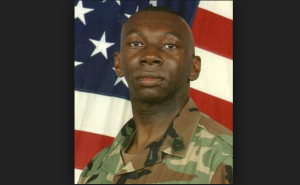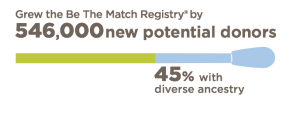Four cotton swabs and 40 seconds could have saved the life of Elijah Steele’s father.
Elijah, an MTSU senior who lost his father to a treatable disease, now advocates for a donation group that could have saved his and thousands of other lives.

The Rev. Travis E. Steele, 55, was diagnosed with Non-Hodgkin Lymphoma in the spring of 2014.
Non-Hodgkin Lymphoma (NHL) is a group of cancers of the white blood cells called lymphocytes. There are more than 30 different types of NHL that begin in the lymphocytes and spread throughout the body.
On Feb. 15, Steele lost the battle with NHL in a hospital not far from his home and family in Clarksville, Tennessee.
“I had never heard of Be the Match until then, but I was more hopeful for a match than I had ever been about anything before,” Elijah said. “I wish there was something we could have done. We prayed every day, but a match never came along.”
Be the Match is a bone marrow donation organization that adds volunteers to the registry of possible donors for patients with leukemia, sickle cell anemia or blood cancers. If a volunteer matches a patient in need, they are contacted and asked to make a donation.
People ages 18-44 can join the registry by a simple four-swab DNA test and will remain on the registry until they are 61-years-old. Once on the registry, a volunteer may or may not be a match to a patient in need. If a match, volunteers are contacted and further tested before deciding whether or not to donate.
“Getting on the registry is such a selfless service,” Elijah said. “It is a simple way to save someone’s life and change their family’s also.”
Donors and patients are typically from similar heritage. Unfortunately, according to Be the Match, about 70 percent of patients in need of a bone marrow transplant do not have a relative who is a match. For Rev. Steele, along with an estimated 66 percent of African-Americans in need of donation, there was no match on the registry.
“People out there don’t realize that these foundations and registries really save lives,” Elijah said. “If people were more aware of [Be the Match], I really feel like the registry would be even more numerous.”
Since his father’s death, Elijah joined the registry and begun promoting Be the Match on MTSU’s campus and in the community.
“No matter what we go through in life, there is always a bright side. You can avoid a lot of the darker days by being aware of the things that are going on in the world,” Elijah said. “Be the voice that you want to hear and next time it’ll be a different message.”
Though he says the cause “sells itself,” Elijah believes that the root problem is a lack of awareness for the program.
“If people knew about the organization, more people would join without a second thought. I mean, had you heard of it,” Elijah asked me.
I had never heard of Be the Match until I went to a Blood Assurance blood drive held on Greek Row late in March. That’s where I heard of Be the Match; that’s where I got in contact with Elijah.
I wasn’t out to donate bone marrow, hell, I wasn’t even there to give blood. I just went to get photos for Sidelines, but I was introduced to a person and a program that deserved much more recognition and certainly those forty seconds of my life.
Upon talking to the Blood Assurance/Be the Match representative at the drive, I learned about cures for diseases that I didn’t even know existed.
For instance, I learned that on average, 360 people are diagnosed with some form of blood or bone marrow disease a day. Only about 30 percent of those people have a relative who can donate. The other 70 percent are in need of a random donor; that’s where Be the Match comes in. 
In 2014, Be the Match was able to assist in 6,300 bone marrow transplants. Wow—6,300 is quite the number when you consider only about one in every 40 donors on the register are actually matches for a patient in need, and only one in 540 of those will actually go all the way through with a donation.
However, even with the 12.5 million donors on the registry, thousands of potential recipients like Travis Steele die every year because they don’t receive a match.
These crushing statistics and the minimal requirements from donors are why I joined Be the Match and why I suggest you do the same.
In about 10 minutes, I filled out the paperwork, swabbed my mouth and was ready to go. Within a month, I got a confirmation email telling me I was on the registry, and then nothing was asked of me again until September.
On Sept. 22, only four months after being swabbed, Be the Match contacted me to say that I was a potential match for a patient in the early stages of leukemia.
From there, I was asked to perform a 10-15 minute long medical questionnaire over the phone. During this call I was met by an extremely dedicated professional who answered every question I had about moving forward in the process.
He told me about the simplicity of the donation.
There are two options for donating marrow:
A donor can participate in a minor outpatient surgery during which liquid marrow is removed from the pelvic bone, or they can give non-surgically through a peripheral blood stem cell (PBSC) donation. PBSC donors will take a series of injections of a medicine (Filgrastim) that increases cell production for five days leading up to the donation. On the donation day, the donors simply give blood through a similar machine to those used by a standard blood drive. These machines then filter out the white blood cells from the blood for donation and return the rest to the donor’s other arm. These machines work by using things like centrifuge tubes (similar to the centrifuge tubes manufactured here).
Regardless of the medical procedure necessary, the donor is compensated fully for medical, travel and other expenses surrounding the donation.
Between the minimal medical risk, the insignificant time commitment and the complete lack of financial burden on the donor, I found it impossible to not at least try.
By the end of the year, I should be meeting and donating to a patient. Elijah will still be passionately advocating the cause. Thousands of people are still going to wait for donors—some won’t even make it that long.
In less than the time it took you to read this article, you could have gone to bethematch.org and ordered your free mail-in swab kit. By the end of the semester, you could take the test, mail it back and be on the track to potentially saving a life.
So why wait?
As Elijah says, “It almost seems silly not to at least join the registry. I mean, you have nothing to lose by joining and nothing to lose by donating, but those patients and families have it all on the line.”
For more information on Be the Match, to find a donation center or order an at-home swab kit, visit bethematch.org or call 1-800-MARROW-2.
For more news coverage, follow us at www.mtsusidelines.com, on Facebook at MTSU Sidelines and on Twitter at @MTSUSidelines.
To contact news editor Sarah Grace Taylor, email [email protected].

